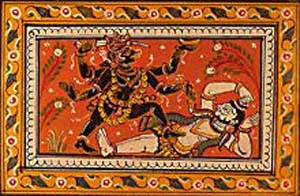
School Deering High School
Project Title Kali: Cross-Cultural (Mis)Understandings
|
|
Kali defeats Daruka; battle-lust; stopped by prostrate Shiva
“In general, Parvati is a benign goddess, but from time to time she exhibits fierce aspects. When this occurs, Kali is sometimes described as being brought into being. For example, Siva asks Parvati to destroy the demon Daruka, who has been given the boon that he can only be killed by a female. Parvati then enters Siva’s body and transforms herself from the poison that is stored in Siva’s throat. She reappears as Kali, ferocious in appearance, and with the help of flesh-eating pisacas (spirits) attacks and defeats Daruka and his hosts. Kali, however, becomes so intoxicated by the blood lust of battle that she threatens to destroy the entire world in her fury. The world is saved when Siva intervenes and calms her.” There are three different traditions as to the method of this calming. The first gives rise to the most common iconography of Kali: Shiva lies down in front of Kali, so that when she steps on him, she is shocked to realize that she is stepping on her husband, and bites her tongue in shame. In the second version, “Siva appears in the middle of the battle field in the guise of an infant cryinig out in thirst. As Kali sees the crying infant, she stops her dancing and puts the infant in her arms” [Gupta 34] (and in some versions nurses him), thus supporting the Chamunda image of Kali as the “great mother.” In a third version Kali is dancing so ferociously in the forest, that a Shivite devotee asks Shiva to restrain her. Rather than lying down in front of her, Shiva challenges her to a dance contest, in the course of which Shiva performs a move in which he shows his private parts. Unwilling to match this display, Kali concedes the victory to Shiva.
|
This site was created by (Susan Barton Young) at the NEH Summer Institute "Cultures and Religions of the Himalayan Region," held at the College of the Holy Cross, Summer 2006


